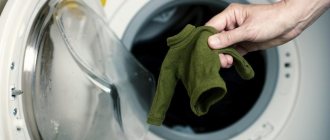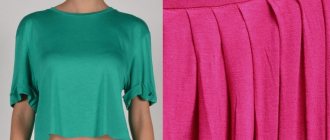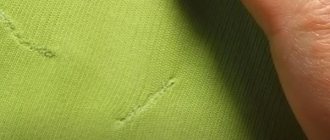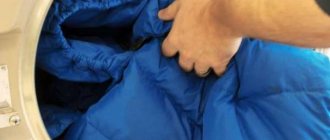Polyester is a synthetic material that is made from polyester fibers, and it has many advantages. So, if the tag of an item says “100% polyester,” this means that the product is very elastic, durable, and delicate. These are the benefits.
But, let's take a step-by-step look at how to wash a polyester jacket in an automatic washing machine and by hand.
The subtleties of washing polyester jackets
Before you start washing a polyester jacket, you need to carefully study the label on it. There, as a rule, a temperature regime is prescribed, which absolutely should not be ignored.
The advantage of polyester is that it does not shrink after washing. And if any stains appear on such an item, you should not use a steamer - you can simply ruin your favorite item.
How and what to wash 100% polyester to completely remove all dirt:
- If the item is light, you need to buy expensive washing powder that does not contain bleach. The best option is to purchase special capsules;
- If the jacket is dark, then you should purchase the same product, only for black things;
- Colored items can be washed with a detergent labeled “Color”.
Important ! If there are no recommendations on the item's label regarding temperature conditions, it is worth setting it to 45-50 degrees. Before throwing an item into the drum, you need to turn it inside out. When rinsing, it is worth adding conditioner - it will make the item as soft and pleasant to the touch as possible.
Why are balls needed and what can replace them?
A good addition to all of the above are balls for washing down jackets. These are sold in hardware stores, usually in quantities of 4 pieces. They are used to ensure that the fluff does not get confused or roll off. Before washing, two balls are placed in the pockets of the down jacket, and two more are simply placed in the drum of the washing machine. Also among the offers you can find magnetic or tourmaline balls. However, these are extremely difficult to find, and their price is higher.
What can you replace the balls with if you can’t find them in stores?
- Tennis balls. Just before washing, check to see if their coating is fading. The dye is not always permanent.
- Massage balls will also be a good replacement for special balls. The main thing is to use rubber, not plastic. The latter can ruin the thing.
- Oddly enough, washed potatoes will do the job. True, there is a risk of leaving stains on dark fabric, so it is best to use young tubers.
How to remove stains as quickly and easily as possible
Synthetic fabrics, as a rule, are not “subject” to the influence of dirt - they rarely develop difficult to remove stains. If the stain has appeared recently, it can be removed by regular rinsing in soapy water. Old dirt can also be easily removed.
Adviсe:
- If the stain is old, before washing the polyester jacket you need to soak it thoroughly, then take a stain remover that does not contain bleach and rub the stain with it;
- Then you should wait about 10 minutes and rinse the item. But to make sure that the product is harmless, you should initially “test” it on a small area of fabric. To do this, you need to take a cotton pad, soak it in stain remover, and apply it to the fabric near the seam. If the paint does not transfer to it and there is no light spot on the item, then the product can be used.
If dirt appears on pockets, cuffs, or collar, then before washing, you should rub these places with a soft brush dipped in soapy water.
- If the stain does not “want” to be washed off, then you can sprinkle it with salt and leave it for half an hour, after which you can wash the item;
- If the dirty area is greasy, apply as much salt as possible to it before washing and leave for 1-2 hours;
- The remaining salt should be rinsed off with running water and washing should begin.
100% polyester, which has many different stains, can be washed with the addition of lemon juice and borax. Borax (10%) is bought at a pharmacy, poured onto a cotton pad, and the stain is soaked with it. Then you need to pour 500 ml into the basin. water, dilute 2 tsp in it. lemon juice and blot the stain.
Removing stains
You can clean stains from polyester using various available methods. For this use:
- Dishwasher - just apply dishwashing detergent for 15-20 minutes, rub the problem area with a soft sponge and rinse off the detergent. If the stain is small in size, then the detergent is applied to a cotton cloth folded several times, and the area with the stain is wiped with this cloth.
- Soap is an effective way to clean the surface of a polyester jacket. To do this, make a soap solution in a small container to create a concentrated liquid, and use it to wipe the contaminated area on the product.
- Table salt - it is used in the traditional way. On shiny places, especially near pockets, on the collar, you need to pour a small amount of salt for 5-10 minutes, lightly wipe the area with salt with a cotton pad, and then wipe off the crystals and continue washing in the usual way.
- Sodium tetraborate - a small amount of the product is applied to the surface of a cotton swab, which is used to wipe the area of contamination.
- Starch is the most difficult to clean the surface of a polyester jacket. The area of contamination is moistened with water, and a paper napkin is placed on the inside. Along the edges of the stain, the stain is sprinkled with starch and covered with a clean, thin cloth. After ironing the iron in the “silk” mode several times, you can shake off the starch and put the jacket in the wash.
Hand washing a polyester jacket
On the one hand, washing outerwear by hand is quite difficult. Much easier - in a typewriter. But, on the other hand, this is a much more “gentle” method that will allow you to maintain the same appearance of the thing longer.
The hand washing process is as follows:
- Heat the water to a temperature of about 30 degrees;
- Pour water into the washing container and stir the polyester cleaning agent into it manually according to the instructions;
- Leave the jacket in the water for about half an hour (if it is very dirty);
- Use your hands to gently wipe all areas with dirt, or use a brush for these purposes (especially in places such as the belt, sleeves, collar);
- Rinse the item in cold running water until it is completely clean.
Hand wash product
If the tag on the jacket allows only hand washing, then doing it is as easy as in a machine. The jacket is prepared for washing in the same way:
- the fur and hood are detachable;
- zippers are fastened;
- pockets are cleaned.
First, warm water (about 35-40 degrees) is poured into the bathtub, liquid detergent is dissolved in it and shaken until foam forms. The jacket is immersed in water, but not soaked.
for washing, it is necessary to treat problem areas with a soft sponge to wipe off greasy stains near pockets and other contaminants;- Hard brushes cannot be used to remove stains - this can damage the fibers;
- You should not rub polyester with your hands, as the item may then lose its attractive appearance;
- after careful washing, rinse the jacket in a large volume of clean water several times until foam stops appearing;
- The item is washed and sent to dry.
How to wash a jacket in a washing machine correctly
Any polyester jacket can be washed in a washing machine. The process should look like this:
- Before putting the item in the drum, you should check all the pockets and turn the jacket inside out;
- The temperature should be set to 50 degrees, no more. Washing mode – “delicate”;
- If there is synthetic padding inside the product, then you should add a detergent like “Weasel” or “Villus”;
- To preserve the appearance of the product, you need to pour a little conditioner into the machine tray;
- Spinning should be done at the lowest speed, otherwise creases may appear on the product;
- Drying is carried out on the balcony. The thing, at the same time, should be hung on a hanger.
If all these recommendations are followed, then there is no need to iron the product after drying - it will retain its original appearance.
If the jacket is filled with down, then washing is done a little differently:
- The mode is set to “manual”, washing powder is poured into the tray, the rinse mode is set without spinning;
- After the process is completed, a second rinse is turned on, a little conditioner is poured into the tray;
- The down jacket is hung on hangers and sent to dry completely in a well-ventilated area;
- The product is shaken every half hour to avoid the formation of lumps of filler;
- As soon as the item becomes dry, it is stored in a horizontal position.
If you wash a down jacket by hand, it should be placed in a basin filled with slightly warmed water. Then add powder to it in the form of a special gel for down products. The most contaminated areas can be lightly rubbed, squeezed, and rinsed thoroughly.
What products can be used to wash a down jacket?
The usual detergents used for laundry are not suitable for washing down jackets. They can negatively affect the natural filler, destroying its organic shell. In addition, ordinary powders and gels do not dissolve in water well enough, are difficult to rinse out of bulky clothes and leave marks.
Detergent for washing down products “Profkhim”
This product is produced by ZAO Ecos-1, is inexpensive, and can be found in stores. This is an affordable product that washes outer fabric well and does not spoil the filling of clothes at all. The disadvantages include the small size of the bottle, only 0.2 liters, and a strong chemical smell (it goes away with additional rinsing).
Subtleties of washing with a membrane
First, it’s worth understanding how the membrane base of the jacket works. After all, like other types of materials from which modern clothes are made, this one also has its own characteristics.
The membrane is a special mesh that has microscopic pores and holes that prevent water from penetrating under clothing.
If you wash such a product incorrectly, you can simply deprive the clothing of its unique properties. And she has a lot of them:
- The membrane perfectly repels water, therefore it does not get wet at all, and even in the rain the product remains completely dry;
- At the same time, the fabric allows air to pass through - “breathes”, and all internal fumes come out. It is impossible to sweat in these clothes;
- The fabric is not blown away even by the strongest wind;
- It is very fabric and does not use down or any other lining.
Now we know all the basic properties of membrane fabric, and we can touch on the issue of washing it.
Features of the material
Polyester is an inexpensive, practical and very popular material. And this is the main problem. More than 60% of clothes are made from polyester, but it is impossible to “recognize” this fabric by sight. Polyester can look like sheer organza, lightweight raincoat fabric, or thick curtain material.
Advice. Before washing the product, read the label carefully. Perhaps what you have in your hands is not polyester at all.
Caring for polyester is easy:
- The fabric does not fade or fade.
- Can be washed both by machine and by hand.
- Things do not sag or stretch.
- Polyester is easy to remove stains from.
There are very few restrictions when washing. Polyester cannot:
- Bleach - untidy faded spots will appear;
- Wash in hot water - the fibers are deformed and the item will become “skewed”;
- Twist it too hard and the fabric will stretch.
But if you decide to wash a polyester down jacket, the situation becomes more complicated.
What laundry detergents can be used?
An important point that should be taken into account even before cleaning the fabric. Many housewives use ordinary washing powder, as well as standard, “habitual” machine washing modes. And they are categorically wrong.
An ordinary substance used for washing will simply ruin the item - the membrane will become clogged with powder granules, stop “breathing”, and lose its positive properties.
Therefore, you need to use specialized substances and wash these clothes on the most “gentle” settings. What substances are most popular:
- DOMAL Sport Fein Fashion. Balm for cleaning sports items, including membrane-based ones. Preserves all the qualities of the material and cleans it as much as possible;
- Nikwax Tech Wash. Impregnates the pores of the material, removing all dirt, and maintains its ability to be waterproof and “breathable”.
- Denkmit Fresh Sensation. The cheapest and quite effective gel. It washes perfectly, but does not have special substances for impregnating the membrane that prolong its “life”;
- Perwoll. A very popular substance. It looks like shampoo, but it has a completely different principle of action.
Important ! You should absolutely not use substances that contain chlorine or any of its derivatives - they are too aggressive for this fabric and will definitely ruin it.
What is polyester, what properties does the fabric made from this material have?
This material means a synthetic fabric, the production of which uses a melt of polyethylene terephthalate and its derivatives.
To improve the aesthetic qualities of the finished fabric, polyester fiber is combined with other types of raw materials: nylon, elastane, cotton, viscose.
Wardrobe items made 100 percent of polyester, as well as mixed materials containing polyester, have the following properties:
- Long service life. Durable material is resistant to strong mechanical stress. It does not wear out and does not lose its original qualities even after numerous washes.
- Color fastness. The material is able to maintain color brightness throughout the entire period of operation. It does not fade when in contact with water and does not fade in the sun.
- Resistance to deformation. Polyester items, especially those containing nylon or elastane fiber, retain their original shape after repeated washing and strong stretching.
- Resistance to the negative effects of aggressive substances, as well as the development of pathogens.
- Low pillability (pellets do not appear on the product).
- Dust and dirt resistance. The fabric retains any type of contaminant on the surface, preventing it from penetrating into the fibers.
- Ease.
- No tendency to absorb unpleasant odors.
- Ability to dry quickly.
- Low creasing. Most wardrobe items do not require ironing.
- Availability. When producing polyester products, manufacturers focus on the average consumer.
- Moisture resistance.
- Easy to care for. If you follow the recommendations for washing items made from this fabric, they will not shrink or fade.
In addition to the positive aspects, clothes made from this fabric also have disadvantages:
- low air circulation in the fibers - due to difficult air exchange in polyester products, it is uncomfortable in hot weather;
- electrification - this fabric has a tendency to accumulate static electricity;
- there is a high risk of skin irritation;
- difficulty of staining;
- fear of high temperatures - when washed in hot water, polyester products shrink.
Washing a membrane jacket
You can go two ways, as always - wash by hand in a basin of warm water, or using an automatic machine. Let's look at each of them.
Handwash
The item is wetted in warm water, any of the products described above is taken, then the stained areas are rubbed, and the item is rinsed in clean water. If necessary, the procedure is repeated.
In the washing machine
The method is also good, but you need to be extremely careful, since the machine can much more easily harm membrane clothing. The process is:
- Place the product in the drum;
- We set the most gentle washing mode. If there is a “sport” mode, then select it;
- Turn off the spin cycle and set the water temperature to 30 degrees;
- Let's start the wash.
After washing
It doesn’t matter whether you washed the membrane item in a machine or by hand, after cleaning you need to gently wring out the item without twisting it. Or wrap it in a dry towel to absorb moisture.
Then the product is placed on a clean horizontal surface and straightened. And all that remains is to wait for the product to dry completely.
This is contraindicated
One of the most important information that you need to know before washing is what you should not expose a polyester product to, so as not to damage it beyond repair. The list of prohibited actions is small, but required reading:
- You definitely can’t boil the thing;
- Do not wash polyester in high temperature water. Compliance with this condition does not depend on the type and quality of the filler. Hot exposure destroys the fabric structure and the result may be a faded and/or significantly shrunk product;
- do not use bleaching agents. Being an aggressive environment, bleach will only seriously damage the material and completely ruin the appearance;
- Drying a jacket in automatic mode and in direct sunlight is contraindicated. The polyester jacket should dry naturally away from heat sources. The ideal option would be to hang it on a balcony with fresh air and no direct sunlight.
How to iron polyester clothes correctly
If a polyester jacket is heavily wrinkled, or there are kinks on it, and it is impossible to do without ironing, you must follow the following rules:
- Make sure this type of polyester is washable. This is indicated on the collar tag. The ironing method and maximum permissible temperature are also indicated there;
- Before ironing, the item should be soaked in cold water and wait until the fabric dries a little;
- Often, when purchasing a synthetic jacket, a piece of similar fabric is added to it. On it you can check which ironing method will be the most optimal;
- All polyester jackets are ironed on the reverse side. In order not to deform the fabric, you should put a thin cotton fabric or gauze on top of it;
- To smooth out a very badly wrinkled area, you can slightly increase the temperature of the iron.
After ironing the jacket, you should not immediately hide it in the closet, but hang it on hangers and wait until it is completely straightened
How to dry it properly?
After washing the jacket, do not wring it out. The most preferred option is natural drying .
The jacket should drain while lying down, then:
- hung on hangers;
- zip up;
- and finish drying.
If there is no place to lay out your jacket, and a large amount of water drains from it, it is recommended to blot the product with a terry towel, wrapping the jacket in it. This way you can get rid of a lot of water. Read more about the rules for drying jackets and down jackets here.
Steaming outer clothing after washing will be useful. This can also be done with polyester jackets. The steamer will smooth out all the wrinkles formed during the washing of the jacket.
If you don’t have a steamer on your household, you can place the product in the bathtub, where hot water flowed for 5-10 minutes. This creates the same soft effect and the fabric gets rid of wrinkles.
As for drying restrictions, the following can be noted:
- You should not hang the product near a radiator or heater - in this case, the material may acquire unsightly antics. Direct sunlight is also not recommended.
- Polyester outerwear cannot be ironed. This can cause unsightly wavy lines if the polyester sticks to the surface of the iron. It will be impossible to get rid of them because the tissue structure is damaged. If there is a steamer in the iron, it is better to use it remotely.
Steam mode
If you use a steam generator or an iron that has this mode, then ironing polyester can be even easier. The process itself is very simple and does not require any serious preparation.
Before carrying out such cleaning, the product is hung in a vertical position on hangers, and the device is set to the mode for steaming delicate fabrics.
The process should start from the back, from top to bottom. But the collar is steamed last. Then the shoulders, sleeves, and then the front side of the jacket are processed.
Important ! During steaming, the iron and steam generator should be kept at a distance of 4-5 centimeters from the fabric.
How do you like the article?
Preparatory stage
The effectiveness of washing depends on many factors, and first of all, on the correct preparation of the jacket. Before you put an item in a washing machine or basin, you need to study the icons on the product label. The tag contains all the important information: names of the material and filler, type and mode of cleaning, drying features, recommended water temperature.
If washing is allowed, it is necessary to prepare the product for the upcoming operation:
- remove contents from pockets;
- disconnect the hood (if it is fastened), fur trim, removable elements;
- fasten the buttons, close the zippers;
- sew up seams, holes, sew on buttons;
- if the jacket has massive metal fittings that cannot be detached, cover it with scraps of white fabric.
Soak
If there are strong stubborn stains on the jacket, pre-soak it. It is not recommended to do this with down jackets and jackets with natural filling: it clumps and clumps in water.
Soaking for 10–15 minutes to remove stubborn stains will be sufficient.
Stains, cuffs and collar are washed with laundry soap.
The greasy areas are soaked and covered with powder that removes heavy dirt. For these purposes, use liquid dishwashing detergent or stain removing gel.
If after soaking some stains still appear, they are washed off with detergent and a sponge.











